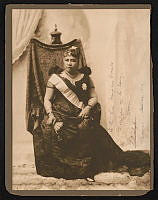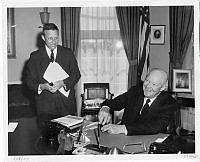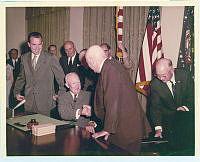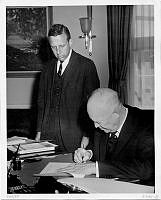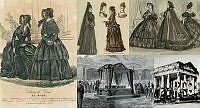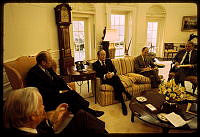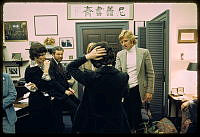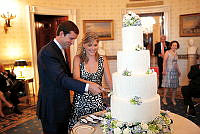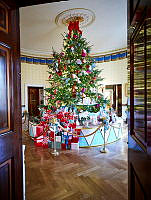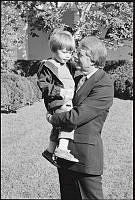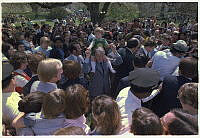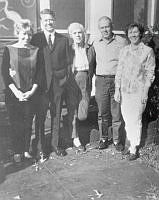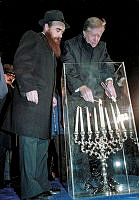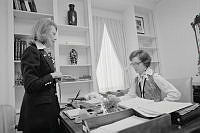"The Most Beautiful Things"
Gifts from France in the Roosevelt White House
Copyright © Summer 2008 White House Historical Association. All rights reserved under international copyright conventions. No part of this article may be reproduced or utilized in any form or by any means, electronic or mechanical, including photocopying, recording, or by any information storage and retrieval system, without permission in writing from the publisher. Requests for reprint permissions should be addressed to books@whha.org
Gallery
-

One of Six bisque figurines designed by French sculptor Agathon Leonard and gifted to President Theodore Roosevelt and Mrs. Edith Roosevelt. The sculptures are based on the modern dances of Illinois native, Loie Fuller.
Photographed by Gavin Ashworth for the White House Historical Association -

One of Six bisque figurines designed by French sculptor Agathon Leonard and gifted to President Theodore Roosevelt and Mrs. Edith Roosevelt. The sculptures are based on the modern dances of Illinois native, Loie Fuller.
Photographed by Gavin Ashworth for the White House Historical Association -

A detail of one of the six Sevres dancers now in the collection of Sagamore Hill, which were given to President Theodore Roosevelt and Mrs. Edith Roosevelt by a French delegation attending the unveiling of the Rochambeau statue in Lafayette Park in 1902.
Photographed by Gavin Ashworth for the White House Historical Association -

A detail of one of the six Sevres dancers now in the collection of Sagamore Hill, which were given to President Theodore Roosevelt and Edith Roosevelt by a French delegation attending the unveiling of the Rochambeau statue in Lafayette Park in 1902.
Photographed by Gavin Ashworth for the White House Historical Association -

One of Six bisque figurines designed by French sculptor Agathon Leonard and gifted to President Theodore Roosevelt and Mrs. Edith Roosevelt. The sculptures are based on the modern dances of Illinois native, Loie Fuller.
Photographed by Gavin Ashworth for the White House Historical Association -

One of Six bisque figurines designed by French sculptor Agathon Leonard and gifted to President Theodore Roosevelt and Mrs. Edith Roosevelt. The sculptures are based on the modern dances of Illinois native, Loie Fuller.
Photographed by Gavin Ashworth for the White House Historical Association -

One of Six bisque figurines designed by French sculptor Agathon Leonard and gifted to President Theodore Roosevelt and Mrs. Edith Roosevelt. The sculptures are based on the modern dances of Illinois native, Loie Fuller.
Photographed by Gavin Ashworth for the White House Historical Association -

One of Six bisque figurines designed by French sculptor Agathon Leonard and gifted to President Theodore Roosevelt and Mrs. Edith Roosevelt. The sculptures are based on the modern dances of Illinois native, Loie Fuller.
Photographed by Gavin Ashworth for the White House Historical Association -

One of Six bisque figurines designed by French sculptor Agathon Leonard and gifted to President Theodore Roosevelt and Mrs. Edith Roosevelt. The sculptures are based on the modern dances of Illinois native, Loie Fuller.
Photographed by Gavin Ashworth for the White House Historical Association
Theodore Roosevelt’s home at Sagamore Hill sits on top of a hill overlooking the Long Island Sound, nestled between properties once owned by his aunts, uncles, and cousins. Built in 1885, it was Roosevelt’s home for thirty-four years, and his wife Edith’s home for another twenty-nine years after his death in January 1919. The house is filled with an eclectic assortment of family furniture, gifts from heads of states, tag sales finds, books, hunting trophies, sculptures and paintings, souvenirs from their travels, and mementos of their family life. Many of these objects are well documented, and their history and significance to the Roosevelts are clear; but for other objects, their “backstories” have been lost or obscured by the passage of time. One of those mysteries concerns a group of ceramic figures of women dancing.
The six bisque figurines stand about 24 inches high and were designed by French sculptor Agathon Leonard. Leonard based his designs on the dances of Loie Fuller, an American-born proponent of modern dance. Fuller’s dances emphasized natural and abstract movements and used colored lights, fabric, and other props to create unique effects and illusions. These characteristics are shown in the figures’ flowing gowns and swaying postures, and in the torches, tambourines, and scarves they are holding.

Born in Illinois in 1862, Fuller grew up performing in traveling shows, vaudeville, and the theatre before becoming interested in dance in the early 1890s. Inspired in part by sunlight shimmering on silk, Fuller realized that dance could be a free-flowing combination of light with movement.
Library of CongressThe dancers were produced by the National Porcelain Factory of Sevres and were available individually or as part of a set of fifteen figures intended for use as a table centerpiece. The “Scarf Dance” set was featured in the Sevres exhibit at the Paris Exposition in 1900 and was both a critical and a commercial success. The French government presented the full set to Tsar Nicholas II during his visit to France in 1901. It is now part of the collections at the Hermitage in St. Petersburg.
The six figures at Sagamore Hill were apparently given to Edith Roosevelt by a French delegation that came to the United States for the dedication of the statue of the Count de Rochambeau in Lafayette Park on May 24, 1902. At the time, relations between France and the United States were strained due to the United States’ recent war with Spain, a longtime ally of France. French envoy Jules Boeufve thought that the statue of the Count de Rochambeau, whose troops had supported George Washington’s victory at Yorktown, would remind both countries of their historical friendship. The dedication ceremony included two thousand official guests and thousands of spectators, speeches by President Roosevelt and French Ambassador Jules Cambon, the presentation of a wreath from the Colonial Dames, and a parade after the official ceremony.1

President Theodore Roosevelt was photographed in the reviewing stand erected for the ceremony.
Library of CongressEdith Roosevelt did not attend the dedication or the State Dinner that had been held on the evening of May 23, 1902. She was still recovering from an illness, possibly a miscarriage, which had kept her bedridden for almost two weeks. Newspaper accounts of the dinner noted her absence and that sixteen-year-old Alice stood in for her stepmother. At the dinner, Alice accepted a set of forty sketches and engravings of Paris as a gift for her stepmother from the French delegation.2 Curiously, the news article makes no mention of the Sevres figurines, and, to date, no references to the presentation of the figurines have been found in Edith Roosevelt’s diaries or letters.
Although it is unclear when the figurines arrived at the White House, there is no question that they were used there. Captain Archie Butt referred to “the Sevres figures which the Rochambeau Commission brought from France and which are always used on the table at state dinners” in a letter to his sister-in-law in 1908.3 In 1922, Edith Roosevelt described the statues to her daughter Ethel as part of a project to document the history of their household furnishings, confirming that they were a gift from the Rochambeau delegation and had been used as centerpieces in the White House.4

Loie Fuller depicted dancing in her signature full-length costume. Her dances are preserved in a film for which she performed.
Library of CongressMore curious is the question of why are there only six figurines. If the French government had given an entire set to the Russian tsar, wouldn’t diplomatic protocol dictate that it give a full set to the American president? If a full set were presented, what happened to the other nine figurines?5 There are no indications that Edith Roosevelt left any of the statues behind at the White House. Given her affection for them, it is doubtful that she would have given any of the statues away as gifts, although doing so was common practice for both her and her husband.
Regardless of when she received them, what is clear is that Edith Roosevelt was very fond of the figurines. In 1909, when an opposition newspaper implied that the Roosevelts were trying to take government property to Sagamore Hill, Edith angrily refused to take a small sofa that she had purchased for use in one of the sitting areas. (President William Howard Taft later paid to have a copy of the sofa made and sent her the original.)6 But even in the midst of that outcry, she never considered leaving the figurines behind. She told Archie Butt that they had been given to her personally and that she had “the documents to prove it.”7 At Sagamore Hill, she displayed them prominently in the new North Room, where they still reside today.8
The author thanks Barbara Nicolls, Charles Markis, Catherine Forslund, and William Seale for their assistance with this article.













